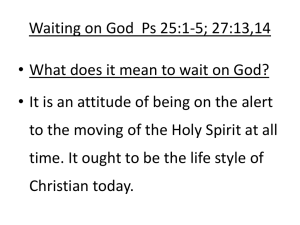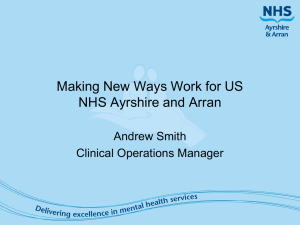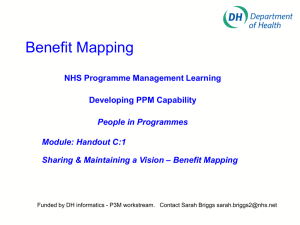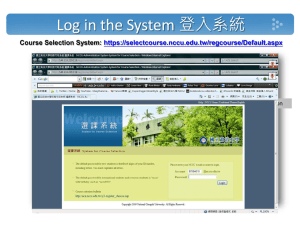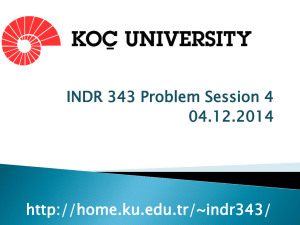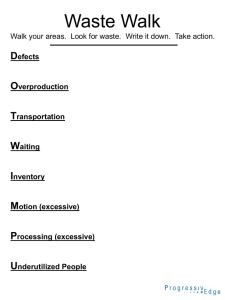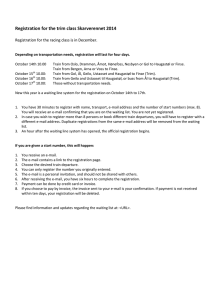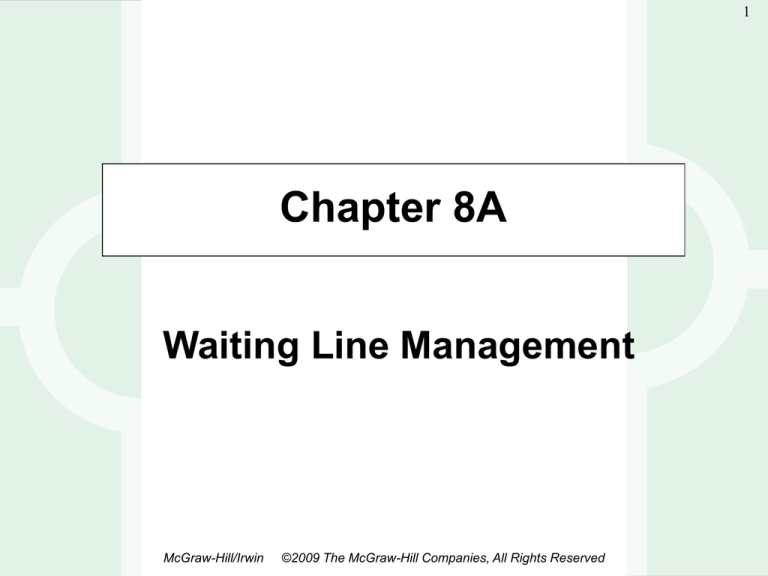
1
Chapter 8A
Waiting Line Management
McGraw-Hill/Irwin
©2009 The McGraw-Hill Companies, All Rights Reserved
1-1
2
Suggestions for Managing Queues
1. Determine an acceptable waiting
time for your customers
2. Try to divert your customer’s
attention when waiting
3. Inform your customers of what to
expect
4. Keep employees not serving the
customers out of sight
5. Segment customers
1-2
3
Suggestions for Managing Queues (Continued)
6. Train your servers to be friendly
7. Encourage customers to come
during the slack periods
8. Take a long-term perspective
toward getting rid of the queues
1-3
4
Components of the Queuing System
Servicing System
Servers
Queue or
Customer
Arrivals
Waiting Line
Exit
1-4
5
Customer Service Population Sources
Population Source
Finite
Example: Number
of machines
needing repair
when a company
only has three
machines.
Infinite
Example: The
number of people
who could wait in
a line for gasoline.
1-5
6
Service Pattern
Service
Pattern
Constant
Example: Items
coming down an
automated
assembly line.
Variable
Example: People
spending time
shopping.
1-6
7
The Queuing System
Length
Queue Discipline
Queuing
System
Number of Lines &
Line Structures
Service Time
Distribution
1-7
8
Examples of Line Structures
Single
Phase
One-person
Single Channel
barber shop
Multichannel
Bank tellers’
windows
Multiphase
Car wash
Hospital
admissions
1-8
9
Degree of Patience
No Way!
BALK
No Way!
RENEG
1-9
10
Waiting Line Models
Model Layout
1
Single channel
Source
Population
Infinite
Service Pattern
Exponential
2
Single channel
Infinite
Constant
3
Multichannel
Infinite
Exponential
4
Single or Multi
Finite
Exponential
These four models share the following characteristics:
Single phase
Poisson arrival
FCFS
Unlimited queue length
1-10
11
Notation: Infinite Queuing: Models 1-3
= Arrivalrat e
= Service rat e
1
Averageservice t ime
1
Averaget imebet ween arrivals
= = Rat io of t ot alarrivalrat e t o sevice rat e
for a single server
Lq Averagenumber wait ingin line
1-11
12
Infinite Queuing Models 1-3 (Continued)
Ls = Averagenumber in syst em
(including t hosebeing served)
Wq = Averaget ime wait ingin line
Ws Average t ot alt imein syst em
(including t ime t o be served)
n Number of unit s in t hesyst em
S = Number of ident icalservicechannels
Pn P robability of exact lyn unit s in syst em
Pw P robability of wait ingin line
1-12
13
Example: Model 1
Assume a drive-up window at a fast food restaurant.
Customers arrive at the rate of 25 per hour.
The employee can serve one customer every two
minutes.
Assume Poisson arrival and exponential service
rates.
Determine:
A) What is the average utilization of the employee?
B) What is the average number of customers in line?
C) What is the average number of customers in the
system?
D) What is the average waiting time in line?
E) What is the average waiting time in the system?
F) What is the probability that exactly two cars will be
in the system?
1-13
14
Example: Model 1
A) What is the average utilization of the
employee?
1-14
15
Example: Model 1
B) What is the average number of customers in
line?
C) What is the average number of customers in the
system?
1-15
16
Example: Model 1
D) What is the average waiting time in line?
E) What is the average waiting time in the
system?
1-16
17
Example: Model 1
F) What is the probability that exactly two
cars will be in the system (one being served
and the other waiting in line)?
1-17
18
Example: Model 2
An automated pizza vending machine
heats and
dispenses a slice of pizza in 4 minutes.
Customers arrive at a rate of one every 6
minutes with the arrival rate exhibiting a
Poisson distribution.
Determine:
A) The average number of customers in line.
B) The average total waiting time in the system.
1-18
19
Example: Model 2
A) The average number of customers in line.
B) The average total waiting time in the system.
1-19
20
Example: Model 3
Recall the Model 1 example:
Drive-up window at a fast food restaurant.
Customers arrive at the rate of 25 per hour.
The employee can serve one customer every
two minutes.
Assume Poisson arrival and exponential
service rates.
If an identical window (and an identically trained
server) were added, what would the effects be on
the average number of cars in the system and the
total time customers wait before being served?
1-20
21
Example: Model 3
Average number of cars in the system
Total time customers wait before being served
1-21





